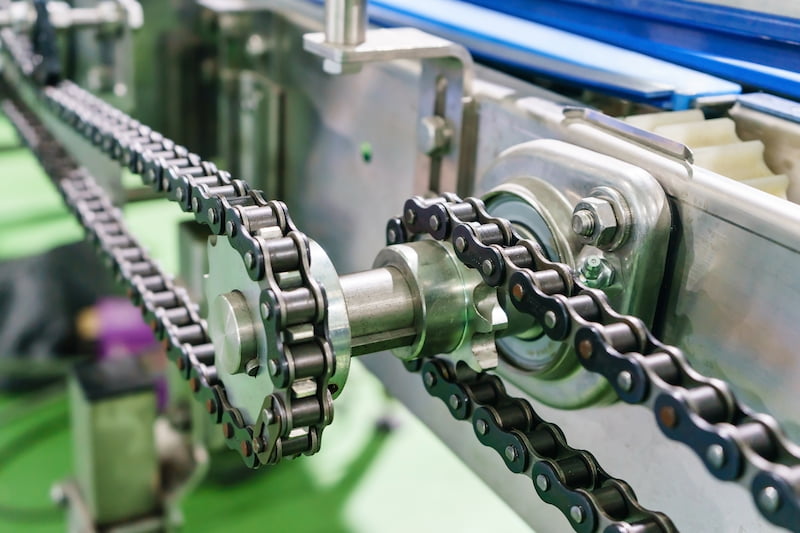Chain drives are most commonly used to transmit power between two components that are at a greater distance, but they may also be used for short distances. They are one of the five most frequently used mechanical power transmission methods alongside shaft couplings, gear drives, belt drives and lead screws. Each method has several advantages and disadvantages over others, which means engineers must be careful before making the final selection.
In this article, we’ll take a look at chain drives and their various types. They are a crucial part of many machines and they can also be used in applications other than just transmitting power, but more on that later. Let’s start from the beginning.
What Is a Chain Drive?
Chain drive is a type of mechanical power transmission system that uses chains to transfer power from one place to another. A conventional chain drive consists of two or more sprockets and the chain itself. The holes in the chain links fit over the sprocket teeth.
When the prime mover rotates, the chain wrapped on the shaft’s sprocket rotates with it. This applies mechanical force onto the driven shaft, transmitting mechanical power in the process.
One of the main advantages over a belt drive is that a chain drive maintains a constant speed ratio, thanks to its zero slip feature. There is no lag in power transfer and hence, it serves as a timing chain in applications such as internal combustion engines. Having no slippage also ensures high mechanical efficiency. The only losses in a chain drive are due to friction between the chain links and the sprocket.
Compared to gears, chain drives are way more versatile when it comes to operating distances. They come into play when shafts are separated at distances greater than that for which gears are practical. Chain drives are efficient at varying distances while still keeping the setup rather compact. They’re found in short-distance applications such as bicycles and long-distance applications such as 5-storey high marine engines. A single chain can power multiple shafts at a time.
Types of Chain Drives
There’s a wide variety of different chain drive designs developed due to finding use in many different mechanical applications. They can be classified into various categories depending on what we choose as a yardstick. When classifying based on their function, chain drives can be divided into three main types.
- Power transmission chain drive
- Conveyor chain drive
- Hoisting and hauling chain drive
Power transmission chain drive
This type of chain drive is specifically used for transmitting power between two shafts. Most machines that produce power cannot consume it at the same place, e.g. pumps with attached motors. Transmission systems convey power to the consumer through different methods. When chains are used for this process, they are known as power transmission chains.
Common examples are bikes, agricultural machinery, compressors, engine camshafts, etc. All these applications use chain drives for power transmission.
Conveyor chain drive
Another common application for chain drives is conveyor chains. Conveyors use chain drives that are crafted especially for material transportation. They come in hundreds of different designs and sport features such as low friction, high temperature- and chemical resistance. They can also be anti-static and magnetic.
Conveyor chain drives find use in industries such as packaging, automotive, food and beverage production, pharmaceuticals and textiles. Attachments can be fitted to conveyor chains to adapt them for various uses.
Hoisting and hauling chain drive
Chain hoists are probably the most common piece of machinery used to lift and lower equipment. They can lift massive weights with very little effort using pulleys.
Hand chain hoists or chain blocks are a common sight in garages, workshops, construction sites, ship engine rooms and in many factories. They can lift/lower heavy loads going up to 20 tonnes. Hoisting chains can be pneumatic, electrical or manual.
We will be focusing on the different types of chains in the next section but since hoisting chains are rather straightforward in their design and field of application, we’ll be covering them here. Hoist chains can be divided into two categories:
- Oval link chains
- Stud link chains
Oval link chains
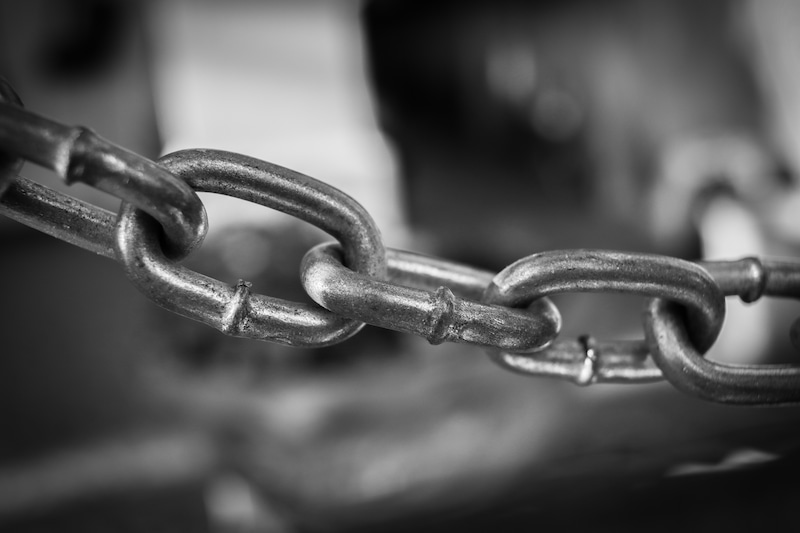
Oval link chains are also known as coil chains. They are commonly used as hoisting chains for low to medium loads and are generally meant to be used in low-speed lifting applications. The chain link is oval-shaped and each one is welded after interlocking.
Sometimes, square link types of chains may be used but they are generally avoided due to poor stress distribution and kinking issues.
Stud link chains
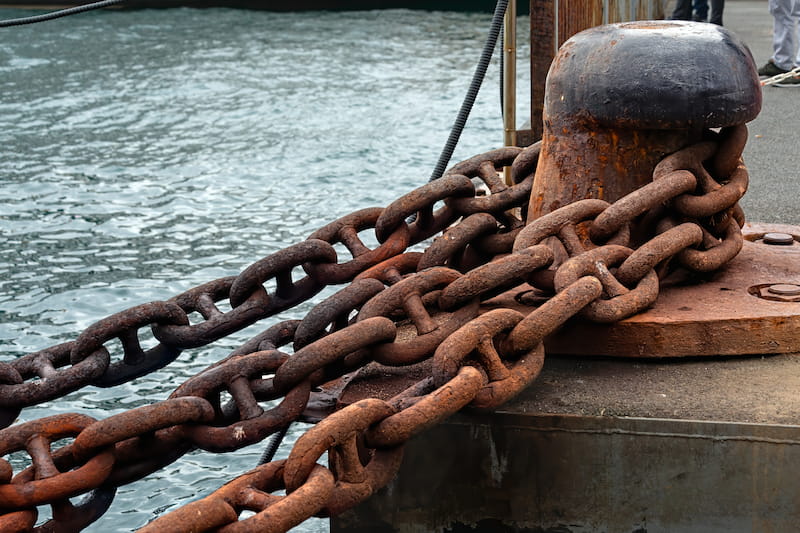
Stud link chains are a better alternative for high-load applications. Each chain link is fitted with a stud across its inner width. The studs prevent kinking and increase strength and durability. Stud link chains find use in ship anchors and in other heavy-duty lifting machines.
Types of Chains in Use
There are many types of chains used in chain drives, each with its own advantages and disadvantages. The five most common types in use are as follows:
- Roller chain (bush roller chain)
- Silent chain or inverted tooth chain
- Leaf chain
- Flat-top chain
- Engineering steel chain
Roller chain
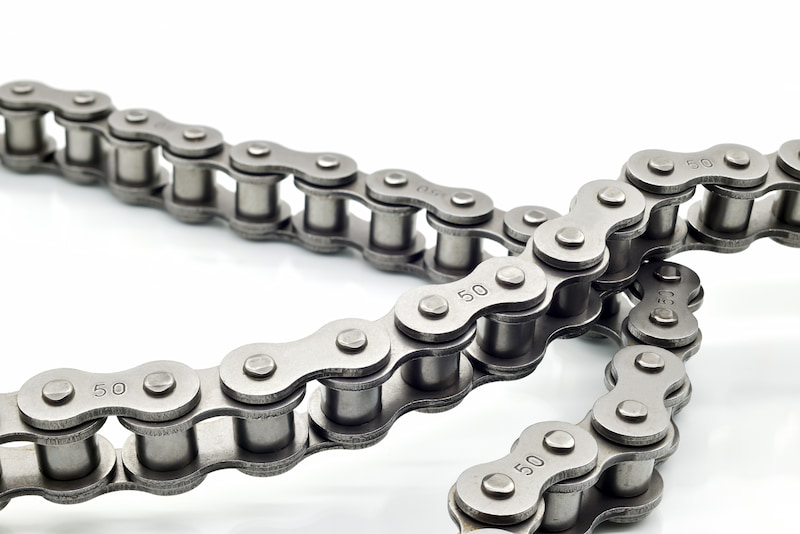
When talking about chains, roller chain is probably the one that comes into most people’s minds. Roller or bush roller chains are widely used for power transmission in bicycles, motorcycles and other applications in the transportation industry. They are usually made from plain carbon steel or from steel alloys.
A roller chain is made up of an inner plate (roller link plate), outer plate (pin link plate), bushes, pins and rollers. The rollers are placed equidistantly between chain links. These rollers engage with the sprocket teeth and transfer power through the chain. An important advantage of roller chains is that they rotate as needed when they come into contact with the sprocket teeth, thus reducing power losses.
In transmission chains, the height of the roller chain link plates (on each side of the roller) is greater than the rollers. This prevents the side plates from making contact with the sprocket during operation. In addition to that, they also act as guides and prevent the roller chain from slipping off.
For roller chains in conveyors, the roller diameter is relatively larger than the height of the sidebars. This prevents contact between the sidebars and the conveyor track and improves efficiency by eliminating translational friction. Larger rollers also reduce rotational friction.
For greater power requirements, designers can opt for multi-strand roller chains. Having multiple strands permits the use of low speeds and small chain pitches for the same load requirements.
Silent chain (inverted tooth chain)
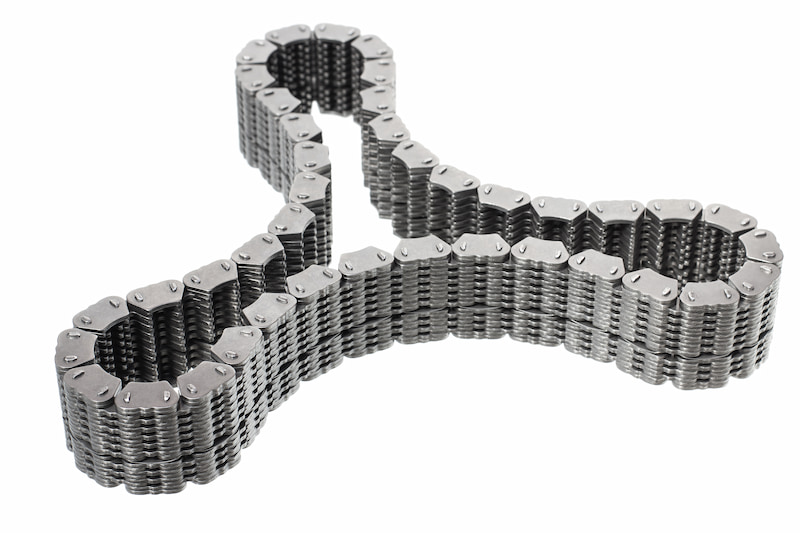
Most chain drives are infamous for their high operational noise. In noise-sensitive environments such as enclosed spaces, mines and residential areas, a quieter chain is more suitable. This keeps the disturbance to the surrounding environment under control and promotes worker well-being.
Enter silent chains, also known as inverted tooth chains. A silent chain can transmit large amounts of power at high speeds while maintaining a quiet operation. The chain consists of flat plates stacked in rows and connected through one or more pins. Each link has the contour of sprocket gear teeth on the underside where it engages with the sprocket teeth.
The load capacity for a silent chain increases with the number of flat plates in each link, and so does the tensile strength and the chain width.
Leaf chain
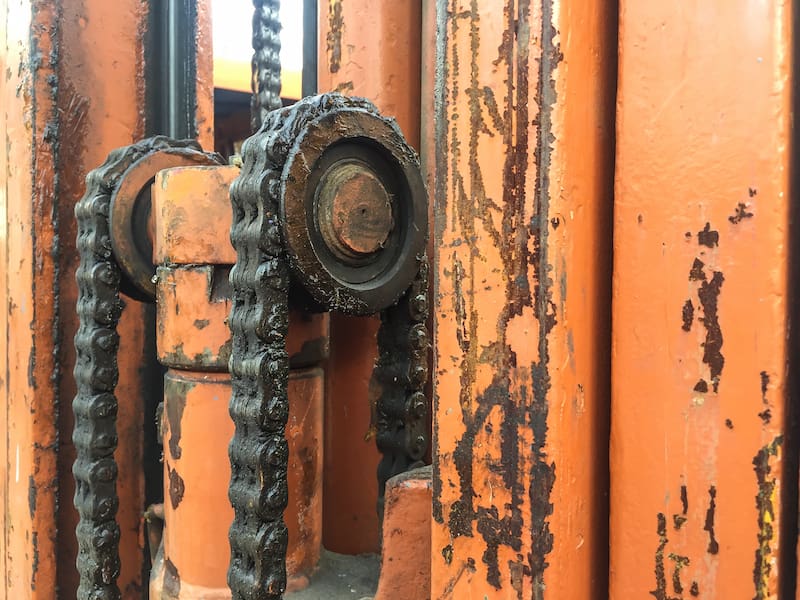
These are the simplest types of chains in use. They consist only of pins and link plates. The link plates are alternated as a pin link and an articulated link. They don’t mesh with sprocket teeth as leaf chains are designed to run over sheaves for guidance.
Leaf chains find use in lifting and counterbalancing applications. Some common examples of applications using leaf chains are lifts, lift trucks, forklifts, straddle carriers and lift masts. In all of these low-speed machines, the lift’s chain endures high static loads and a small amount of working load. Leaf chains can handle shock and inertia better than other chain designs.
All lift chains must be capable of handling high tensile stresses without elongating or breaking. They must have sufficient ductility to endure fatigue. As always, lubrication and service environment must be given their due thought already in the design process.
Flat-top chain
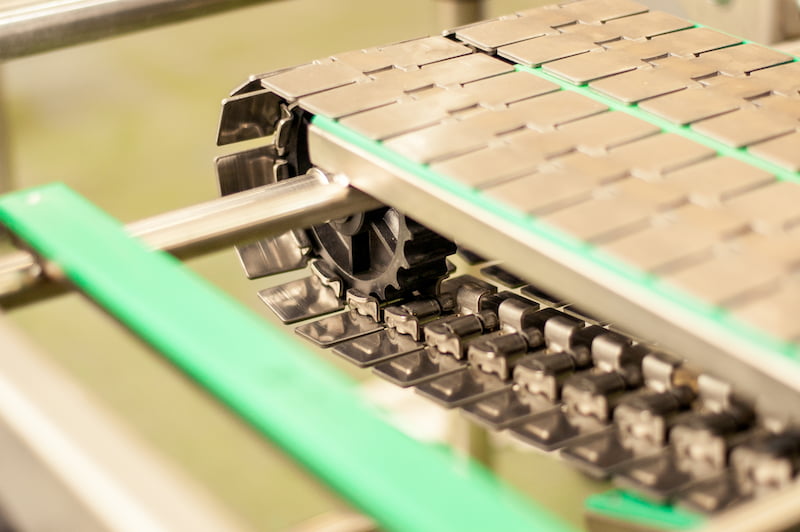
Flat-top chains are intended only for conveying. They can replace conveyor belts and belt drives as the material can be carried directly on its links. An individual link is usually made out of a steel plate with barrel-shaped hollow protrusions on its bottom side. The links are connected to preceding and succeeding links by passing a pin through these protrusions underneath the links. The nature of these joints allows movement only in one direction.
There are special types of flat-top chains that can flex sideways. The pin construction permits sideways movement in both directions to enable the conveyor chain to go around curves.
Flat-top chains are used in low-speed conveyor machines for material transportation in assembly lines.
Engineering steel chain
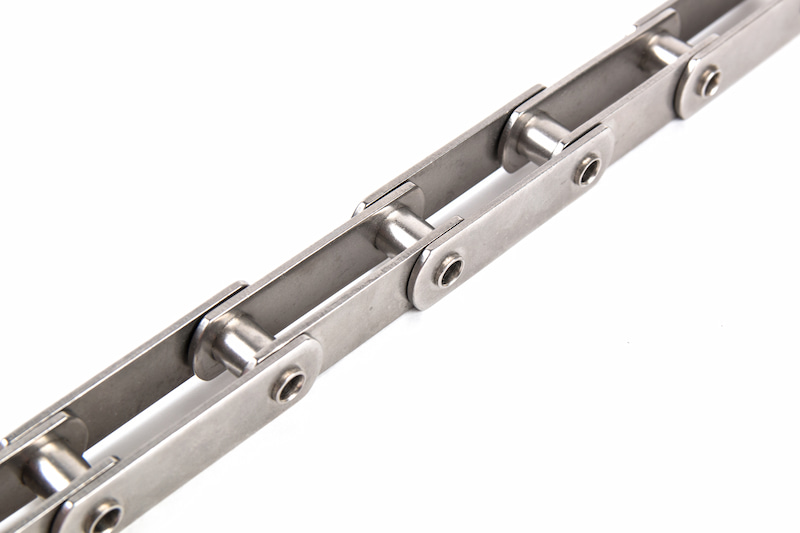
The engineering steel chain has been around since the 1880s. This chain was designed to handle the toughest environments and the most demanding applications. They were made of hot-rolled steel and sometimes heat-treated for extra strength.
Engineering steel chains are just as relevant today. However, their strength, wear rate, loading capacity and pitch have increased to match present-day industrial needs.
These chains consist of links and pin joints. The clearance between this chain’s components is larger than other chains as it has to handle dust, dirt and abrasives under normal operating conditions.
Most engineering steel chains function as conveyor chains for material handling but some are also used in drives. They can be seen in applications such as conveyors, forklifts, bucket elevators and oil drilling machines.
- Personal account manager
- Quality assurance
- Payment terms for companies
- On-time delivery by Fractory
How to Select the Right Chain Drive for Your Application
With the amount of variety in the form and function of various chain designs, selecting the right chain drive for an application can become a bit overwhelming. The right way to go about this selection is to eliminate unsuitable options by evaluating the chain’s application and features. This will help to narrow down viable options before the final selection. The most important factors in chain drive selection are as follows:
- Loading
- Chain speed
- Shaft layout
- Distance between the shafts
- Service environment
- Lubrication
Loading
When selecting the right chain drive for your application, the most important question to focus on is how much power needs to be transferred. The chain must be able to handle the power produced by the prime mover.
The safety of the crew and the chain drive system depends upon the correctness of the calculations at this stage. It is recommended to work with an adequate factor of safety.
Chain speed
Not all chain drives can handle high-speed applications. Some chain drives are specifically designed for low speeds. The specifications can be obtained by carrying out calculations and ensuring that the speed is within the recommended range. This evaluation will considerably narrow down the number of designs that can be used for the application.
Shaft layout
Most chain drives cannot work with non-parallel shafts. If the shafts aren’t exactly aligned, the designers may have to look towards gear drives as an alternative.
Distance between the shafts
It is recommended that the center distance between shafts be in the range of 30-50 times the chain pitch. The designer must also ensure that a minimum arc of contact of 120 degrees is obtained on the smaller sprocket. If the number of sprocket teeth is small, at least five teeth must be in contact with the chain at any given moment.
Service environment
The service environment will dictate the expected resistance of the chain drive to moisture, dirt, abrasives, corrosion and high temperature. It will also affect other parameters such as vibration, noise levels and fatigue strength. For instance, in areas where noise is a concern, the designers can opt for the use of an inverted tooth chain.
Lubrication
Most chain drives require lubrication for a satisfactory wear life. Chain type, size, loads and operating speed will dictate the need and extent of lubrication. Depending on the application, designers may prefer manual, drip feed, oil bath or forced feed lubrication.
Some chains are self-lubricated and do not require any external lubrication throughout their service life. Such chains use bushings made from oil-infused sintered plastics or metals that provide uninterrupted lubrication during operation.
Advantages of Chain Drives
- Able to transfer torque over long distances
- Contrary to a belt drive, a chain drive does not slip
- A chain drive is more compact than a belt drive and can fit into relatively tight spaces
- Multiple shafts can be powered by one chain drive
- Versatile drive that can work at high temperatures and in all kinds of service environments (dry, wet, abrasive, corrosive, etc.)
- It is a low-friction system that guarantees high mechanical efficiency
Disadvantages of Chain Drives
- Cannot work with non-parallel shafts
- Chain drives are known to be noisy and they can also cause vibrations
- Misalignment may cause the chain to slip off
- Some designs require constant lubrication
- An enclosure is usually needed
- They require chain tensioning from time to time in the form of a tightening idler sprocket


